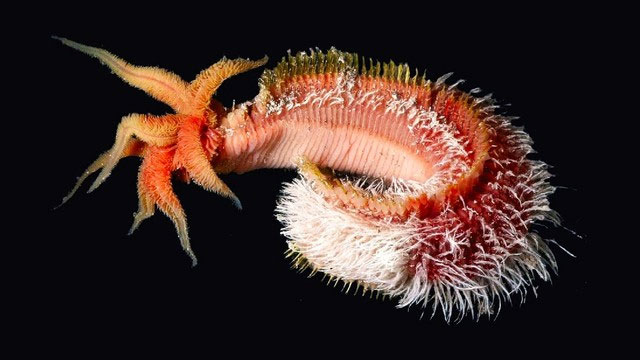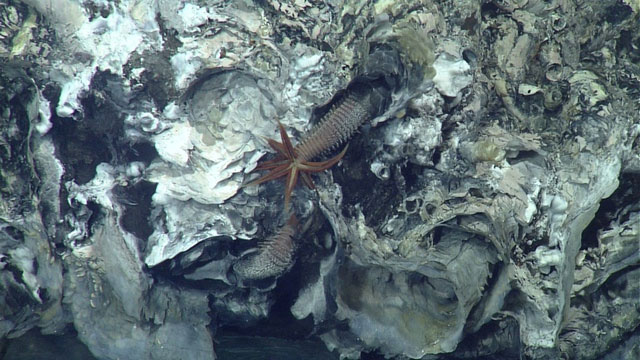The Mystery of Pompeii Worms - The Bizarre Creature That Even Lava Can't Kill!
How did Pompeii worms withstand the high temperatures of the volcano? Scientists have conducted studies to try to unravel this mystery.
Discover and characterize the animal species with the strongest heat resistance on Earth
The Pompeii worm was first discovered in the ruins of Pompeii, Italy, which was buried in a volcanic eruption in 79 AD. Most of the city's buildings and artifacts were preserved due to the layer of volcanic ash and high-temperature lava flows. While excavating the site, scientists accidentally discovered a previously unknown creature, the Pompeii worm .

Pompeii worms were first discovered in the ruins of Pompeii, Italy.
One of the main characteristics of Pompeii worms is their extreme adaptability to high temperatures. Scientists have found through experiments that Pompeii worms can survive at temperatures of 300 degrees Celsius for several hours. Compared to other organisms, their cell structure is more complex, they have stronger DNA repair capabilities, and can resist damage caused by high temperatures. In addition, Pompeii worms are also resistant to drought and lack of oxygen , so they can survive in harsh environments.
Scientists are very interested in the discovery of the Pompeii worm because its properties could have important implications for humans. First, the discovery of the Pompeii worm demonstrates the resilience and adaptability of life. Their ability to survive in extreme conditions suggests that life can find a chance to survive in many harsh environments. This also gives scientists hope to study whether life exists on other planets such as Mars.

Pompeii worms have the ability to adapt extremely to high temperatures. (Illustration photo).
The DNA repair ability of Pompeii worms also has great significance for human health research. Scientists can learn from the gene repair mechanism of Pompeii worms to develop more effective DNA repair technology, thereby providing new ideas for treating human diseases.
However, the adaptability of Pompeii worms is not without limitations. Although they can survive in harsh environments, their numbers are very low and their distribution range is relatively limited. Scientists believe that this may be due to the Pompeii worms' poor reproductive ability and their unique feeding habits . Therefore, the protection of Pompeii worms has become a common goal of scientists.

The reproductive capacity of Pompeii worms is very poor. (Illustration photo).
Survival strategies and adaptations of worms after volcanic eruptions
Pompeii worms increase their chances of survival through active hiding behavior. When a volcano begins to erupt, they can sense tremors in the ground and changes in the volcanic atmosphere. This heightened awareness allows them to anticipate impending disasters and take appropriate action. Research shows that Pompeii worms migrate to safer locations before a volcanic eruption to avoid being buried in ash and lava.
Pompeii worms have amazing adaptability. After the volcanic disaster, the entire city of Pompeii was buried under a thick layer of volcanic ash, creating a completely closed environment. However, Pompeii worms were able to survive by adapting to their surroundings. Most organisms cannot survive in such an environment due to the lack of oxygen and high temperatures, but Pompeii worms have the ability to store oxygen through their breathing tubes and special oxygen storage sites and survive under volcanic ash.

Pompeii worms have amazing adaptability. (Illustration photo).
Pompeii worms also cooperate with each other to increase their chances of survival. After a volcanic eruption, they tend to gather together to form Pompeii worms. By cooperating with each other, they can face many challenges from the outside world together and adapt to the environment with a higher chance of survival.
To understand the mechanism of Pompeii's heat resistance, scientists have conducted a lot of research. They found that this animal is covered by a special community of bacteria that produces a special protein that helps it withstand high temperatures. This protein helps Pompeii resist high temperatures and protects the cells in their bodies from damage. In addition, these bacteria can secrete a special mucus that helps Pompeii worms stay moist at high temperatures and avoid dehydration.
In addition to the bacterial population on their bodies, Pompeii worms have also developed a complex and unique set of physiological mechanisms through evolution. Their cell walls are relatively thick, which can effectively insulate the cells from damage caused by high temperatures. Furthermore, Pompeii cells contain a special enzyme that can help regulate the temperature inside the cell and resist the effects of high temperatures.

Pompeii worms also develop a complex and unique set of physiological mechanisms. (Illustration photo).
The body structure of Pompeii worms is also closely related to their ability to adapt to heat. Their bodies are straight and covered with many hairs. These hairs increase the surface area and provide more heat dissipation channels, helping Pompeii worms to lower their body temperature. At the same time, these hairs can also help Pompeii worms absorb nutrients from the surrounding environment and provide them with the necessary energy.
The Pompeii worm's ability to withstand heat is not only a survival strategy, but also gradually formed in the process of evolution. Due to the extremely harsh environment near deep-sea hydrothermal vents, it is difficult for normal animals to survive here. Through the process of evolution and evolution, Pompeii worms have gradually developed the ability to withstand heat, giving them an advantage in surviving in this special environment.
- Thought seaweed hooked, turned out to be strange marine creatures with extremely venom
- The most diverse worm species on the ocean floor
- The mystery of the worms 'living worms', though killed hundreds of times
- Explain the mystery of the ancient tombs in Pompeii
- Decipher the mystery of the most strange creature ever discovered
- Shiver strange creatures like coming from aliens in Serbia
- Decipher the mystery who runs on molten lava
- The mystery of the destruction of Pompeii citadel
- Fluttering before the images of the mysterious
- Archaeologists are amazed at the 5,000-year-old 'Scottish Pompeii' ruins
- What is lava?
- The bizarre 'bird's head' is making this network of people really real?
 Surprised: Fish that live in the dark ocean still see colors
Surprised: Fish that live in the dark ocean still see colors Japan suddenly caught the creature that caused the earthquake in the legend
Japan suddenly caught the creature that caused the earthquake in the legend A series of gray whale carcasses washed ashore on California's coast
A series of gray whale carcasses washed ashore on California's coast Compare the size of shark species in the world
Compare the size of shark species in the world